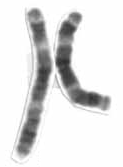3q29 Microdeletion Syndrome

A recurrent subtelomeric deletion syndrome with variable clinical manifestations including intellectual deficit and dysmorphic features.
Epidemiology
It has been described in 23 patients.
Clinical description
The clinical phenotype is extremely variable. The most common features include mild-to-moderate intellectual deficit and slightly dysmorphic facial features: microcephaly, long and narrow face, short philtrum, large posteriorly rotated ears and high nasal bridge. Autism and gait ataxia have been noted occasionally. Congenital malformations are not common: there are only rare reports of horseshoe kidney, hypospadias and congenital heart defects (patent ductus arteriosus).
Etiology
The syndrome is caused by a recurrent deletion of the 3q subtelomeric region. The microdeletion is commonly 1.6 Mb in length and encompasses more than 20 genes. It was identified by comparative genomic hybridization (CGH) microarray or fluorescence in situ hybridization (FISH) and the underlying mechanism is likely non-allelic homologous recombination (NAHR). Most of the deletions appear de novo but a few of them were inherited from mildly or non-affected parents. More recently an infant and his father, both with 3q29 microdeletion and cardiac defects, were described as intellectually normal.